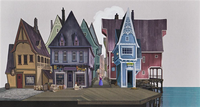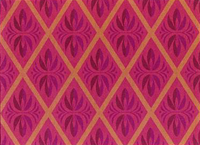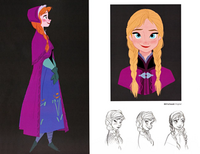m (+Image.) |
(Rewrite for clarity.) |
||
| Line 45: | Line 45: | ||
==== Hans ==== |
==== Hans ==== |
||
| + | [[Hans]] was a special case for the writers and artists alike; in many of their films, Disney had already depicted characters undergoing transformations, such as Aladdin and Cinderelle going from low social standing to royalty. However, Hans would transform from benevolent prince to power-hungry villain. |
||
| − | Usually,the hero or heroine of a film undergoes a transformation:Aladdion goes from street rat to price;Cinderella begins as a de facto servant and ends up a pricecess.In ''[[Frozen]]'',Hans goes from courtly charmer to power hungry villain.When he appears during the coronation sequence,Hans embodies courtly charm.His polished looks and manners immediately win Anna's attention."Hans is this handsomedashing character:You want the audience to fall in love with him and the relationship he could have with Anna.The biggest chanllenge designing Hans was make sure we covered all aspects of his personality while never fully tipping our hand to the audience.So Hans always want to with Anna together. |
||
| + | |||
| + | When the twist in Hans' character was revealed, many animators leapt at the chance to animate the prince and his two different personalities. Bill Schwab, Hans' design supervisor stated that the hardest task "was to make sure [they] covered all aspects of [the prince's] personality while never fully tipping [their] hand to the audience." Hans' costume was inspired by the traditional short-waisted bunad; its black lapels and collar were meant to convey "heroic strength." Hans was also given epaulets and an aiguillette to add "princely bearing." |
||
==== Costume design ==== |
==== Costume design ==== |
||
Revision as of 23:06, 29 November 2014
Template:BookThe Art of Frozen is an art book written by Charles Solomon. It features concept sketches and paintings, storyboards, and finished art alongside behind-the-scenes commentary from the animators, production artists, and writers.
Book Description
- In Walt Disney Animation Studios upcoming film, Frozen, the fearless optimist Anna sets off on an epic journey—teaming up with rugged mountain man Kristoff—to find her sister Elsa, whose icy powers have trapped the kingdom of Arendelle in eternal winter. Encountering Everest-like conditions, Anna and Kristoff battle the elements in a race to save the kingdom. The Art of Frozen features concept art from the making of the film—including character studies and sculpts, color scripts, storyboards, and more—alongside interviews with the film's artists about the making of this comedy-adventure.
Contents
The book contains four chapters:
- Coronation
- Wilderness
- Ice palace
- Return to Arendelle
It contains a preface from the executive producer, John Lasseter, and a foreword from the directors, Jennifer Lee and Chris Buck. It also includes an introduction about the transition from Hans Christian Andersen's fairy tale, The Snow Queen, to Frozen; this is expanded upon in the prologue, which describes how the film ultimately became a story about two sisters. Descriptions of the different characters and insight on their development are interspersed throughout the chapters.
Chapter 1: Coronation

The village featured in Frozen drew heavily upon the designs of the Norwegian village of Balestrand, particularly the asymmetrical placement of buildings.
Early in the production of the film, it was decided that Arendelle was to be based on Scandinavia. Chris Buck and John Lasseter both approached their good friend from CalArts, Michael Giamio, to take up the role of art director for the film and oversee the creation of a world with a "level of complexity and attention to detail from costume to character" that had never been done in a computer-generated film. Along with assistant art director, Lisa Keene, production designer David Womersley, and some other artists, Giamio visited California's Danish village of Solvang, where they learned that there were many Scandinavian cultures, each with their own specific traditions. Eventually, the film shifted its focus particularly on Norwegian architecture and culture.
Realizing that a search engine could only yield so many results, a group of artists went to Norway to do visual research for the film. The artists visited the Norwegian village of Balestrand, which would provide the primary inspiration for the structure of the village featured in the film, the chapel where Elsa was coronated, and various other architectural styles for the kingdom as a whole. The village is specifically based on the Norwegian "Dragonstil" style of architecture, a late nineteenth century blend of Victorian aesthetics with rustic Norwegian designs. The castle, on the other hand, drew inspiration from twelfth century Norwegian stave churches, featuring both a similar roof line and detailing.

The artists of Frozen utilized the Norwegian pattern style of rosemaling, which features intricate floral designs. Rosemaling is featured on both sets and character costumes.
Artists were particularly struck by the immense presence of rich patterning, textures, and shapes featured in Norway. One such source of patterning was rosemaling, Norwegian for "decorative painting". It is an intricate ornamentation style that arose from Eastern Norway in the mid-eighteenth century and was widely used by Disney artists to decorate both the costumes and sets. There was somewhat of a challenge in integrating such a level of detail into the film in a manner that did not overwhelm the viewers, and the artists worked tirelessly to ensure all the colors and patterns harmonized to produce a look that was "fresh and lively, but not too dense."
With a general sense of the setting of the film determined, the writers and artists were ready to apply this to the characters.
Anna

Concept art of Anna.
After the success of Disney's Tangled, it was difficult to make Anna the central character of the film, since is she markedly different from Rapunzel, a heroine associated with the supernatural. Though this was a deterrence, the writers and artists ultimately accepted that Anna would be her own character; animating Anna produced movements that were distinctly different from Rapunzel, as they were more quick and quirky. And despite her lack of a power, head of story Paul Briggs stated Anna's greatest strength comes from her willingness to stand beside others.
Anna's costumes were subjected to rigorous aesthetic standards to fit both her title and personality. For her travel outfit, the goal was to apply a striking and bold look that was elegant at the same time; to achieve this, Anna was given rich saturated hues like blue and magenta, colors that suggest royalty. To reflect Anna's sunny nature, her outfits over the years used warm colors like grayed yellow greens, ochre, and olive.
Elsa
Another difference with Frozen was the presence of a second protagonist. Briggs states, "Elsa is interesting because she could be perceived as the villain, but she's not." Elsa starts as a repressed character who is forced to hide her true self and, above all else, needs someone to stand by and help her.
In bringing Elsa to life, the goal was to focus on her abilities. Her ice dress is a testament to her winter magic and designed to be suggestive of an ice crystal; the palette contains a walking effect in which the colors will reflect and refract. Giamio also gave Elsa an analogous color scheme of icy and warm blues for a "striking effect."
Hans
Hans was a special case for the writers and artists alike; in many of their films, Disney had already depicted characters undergoing transformations, such as Aladdin and Cinderelle going from low social standing to royalty. However, Hans would transform from benevolent prince to power-hungry villain.
When the twist in Hans' character was revealed, many animators leapt at the chance to animate the prince and his two different personalities. Bill Schwab, Hans' design supervisor stated that the hardest task "was to make sure [they] covered all aspects of [the prince's] personality while never fully tipping [their] hand to the audience." Hans' costume was inspired by the traditional short-waisted bunad; its black lapels and collar were meant to convey "heroic strength." Hans was also given epaulets and an aiguillette to add "princely bearing."
Costume design
The elaborate costumes on Elsa and Anna were enormous challenges on this film in order to sustain its appeal.We had dressed that trekked through deep snow,clothing that survived a chase and capes that endured a winter storm.All in the spirit main character and keeping the believability of how their costumes would react in the various circumstance.Hans costume design was inspired by the traditional Norwaigan short waisted male Bunad jacket.
